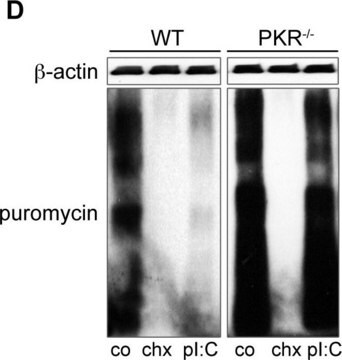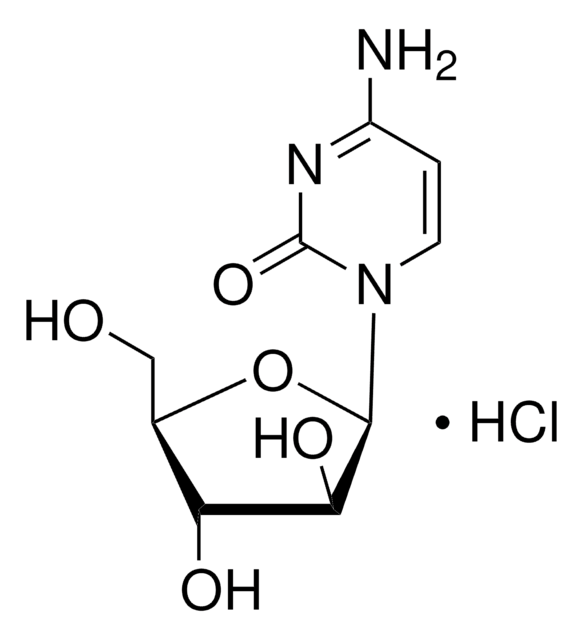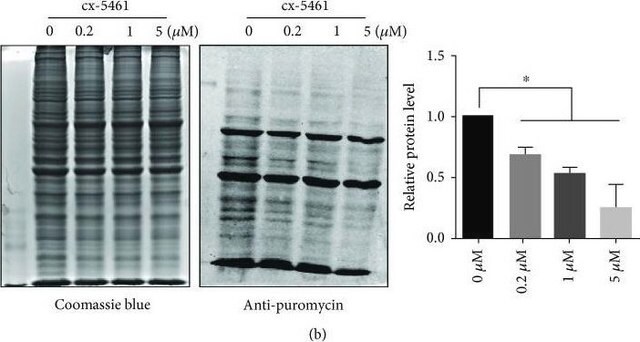Alle Fotos(1)
Wichtige Dokumente
P8333
Anti-Protein Kinase Cδ antibody produced in rabbit
whole antiserum
Synonym(e):
Anti-PKC δ
Anmeldenzur Ansicht organisationsspezifischer und vertraglich vereinbarter Preise
Alle Fotos(1)
About This Item
Empfohlene Produkte
Biologische Quelle
rabbit
Qualitätsniveau
Konjugat
unconjugated
Antikörperform
whole antiserum
Antikörper-Produkttyp
primary antibodies
Klon
polyclonal
Enthält
15 mM sodium azide
Speziesreaktivität
rat
Methode(n)
dot blot: 1:50,000
microarray: suitable
western blot: 1:10,000 using rat brain extract
UniProt-Hinterlegungsnummer
Versandbedingung
dry ice
Lagertemp.
−20°C
Posttranslationale Modifikation Target
unmodified
Angaben zum Gen
rat ... Prkcd(170538)
Verwandte Kategorien
Allgemeine Beschreibung
Protein Kinase C (PKC) is a family of serine/threonine (Ser/Thr)-specific protein kinases. PKC is a phospholipid-dependent enzyme, activated by the lipid 1,2-diacylglycerol (DAG). The protein kinase C delta (PKC δ) isoenzyme appears to be widely expressed in the brain, lung, heart, spleen, liver, ovary, pancreas, thymus, adrenal gland, skin and rat embryonic fibroblasts, and is expressed in lower levels in certain mouse fibroblasts. PKD is also located in the cytosol, nuclear compartment and in mitochondria in response to cellular stress.
Spezifität
Anti-Protein Kinase C δ specifically reacts in dot-blot immunoassay with PKC δ peptide conjugated to BSA with 1-ethyl-3-(3-dimethylamino-propyl)-carbodiimide (EDCI).
Immunogen
Synthetic peptide corresponding to the C-terminal variable (V5) region (amino acids 662-673) of rat PKC δ coupled to KLH with glutaraldehyde.
Anwendung
Anti- protein kinase c δ antibody may be used in:
- immunoprecipitation
- immunohistochemistry
- immunoblotting
- ELISA
- chemiluminescence detection systems to detect PKC δ
- dot-blot immunoassay
Applications in which this antibody has been used successfully, and the associated peer-reviewed papers, are given below.
Western Blotting (1 paper)
Western Blotting (1 paper)
Biochem./physiol. Wirkung
Protein Kinase C isotype δ (PKCδ) modulates the inflammatory response. It acts as a signal transducer of several signaling pathways. Hence it can be considered as a vital therapeutic target to treat sepsis induced-lung injury. In sepsis, PKCδ participates in platelet-mediated activation. Overexpression and stimulation of PKC δ leads to cell division arrest in Chinese hamster ovary (CHO) cells and growth inhibition of NIH3T3 cells.
Protein kinase C (PKC) has a pivotal role in cell growth and differentiation, modulation of neurotransmission, signal transduction and oncogenesis. Anti-protein kinase c δ antibody can be used for studying the differential tissue expression and intracellular localization of PKC δ. It can also be used in western blotting and microarray.
Physikalische Form
Rabbit Anti-Protein Kinase C δ is supplied as liquid containing 0.1% sodium azide as preservative.
Lagerung und Haltbarkeit
For continuous use, store at 2-8 °C for up to one month. For extended storage freeze in working aliquots. Repeated freezing and thawing is not recommended.Storage in "frost-free" freezers is not recommended. If slight turbidity occurs upon prolonged storage, clarify the solution by centrifugation before use.
Haftungsausschluss
Unless otherwise stated in our catalog or other company documentation accompanying the product(s), our products are intended for research use only and are not to be used for any other purpose, which includes but is not limited to, unauthorized commercial uses, in vitro diagnostic uses, ex vivo or in vivo therapeutic uses or any type of consumption or application to humans or animals.
Sie haben nicht das passende Produkt gefunden?
Probieren Sie unser Produkt-Auswahlhilfe. aus.
Hier finden Sie alle aktuellen Versionen:
Besitzen Sie dieses Produkt bereits?
In der Dokumentenbibliothek finden Sie die Dokumentation zu den Produkten, die Sie kürzlich erworben haben.
Sean M Crosson et al.
Molecular therapy. Methods & clinical development, 10, 1-7 (2018-08-04)
Adeno-associated virus (AAV) is one of the most promising gene therapy vectors and is widely used as a gene delivery vehicle for basic research. As AAV continues to become the vector of choice, it is increasingly important for new researchers
Manuela Cerezo et al.
European journal of pharmacology, 522(1-3), 9-19 (2005-10-06)
The present study was designed to investigate the possible changes of protein kinase A (PKA) and different isoforms of protein kinase C (PKC): PKC alpha, PKC delta and PKC zeta after naloxone induced morphine withdrawal in the heart. Male rats
Ikuko Koyama-Honda et al.
Autophagy, 9(10), 1491-1499 (2013-07-26)
Autophagosome formation is governed by sequential functions of autophagy-related (ATG) proteins. Although their genetic hierarchy in terms of localization to the autophagosome formation site has been determined, their temporal relationships remain largely unknown. In this study, we comprehensively analyzed the
Protein kinase D activation induces mitochondrial fragmentation and dysfunction in cardiomyocytes
Jhun BS, et al.
The Journal of Physiology, 596(5), 827-855 (2018)
Peidu Jiang et al.
Molecular biology of the cell, 25(8), 1327-1337 (2014-02-21)
Membrane fusion is generally controlled by Rabs, soluble N-ethylmaleimide-sensitive factor attachment protein receptors (SNAREs), and tethering complexes. Syntaxin 17 (STX17) was recently identified as the autophagosomal SNARE required for autophagosome-lysosome fusion in mammals and Drosophila. In this study, to better
Unser Team von Wissenschaftlern verfügt über Erfahrung in allen Forschungsbereichen einschließlich Life Science, Materialwissenschaften, chemischer Synthese, Chromatographie, Analytik und vielen mehr..
Setzen Sie sich mit dem technischen Dienst in Verbindung.






